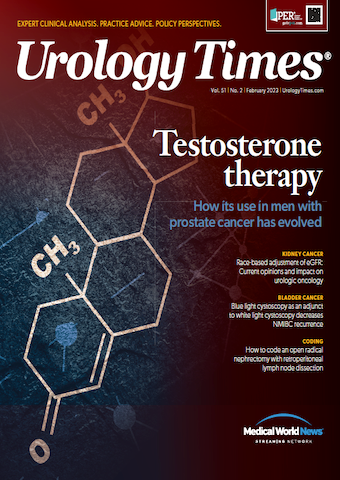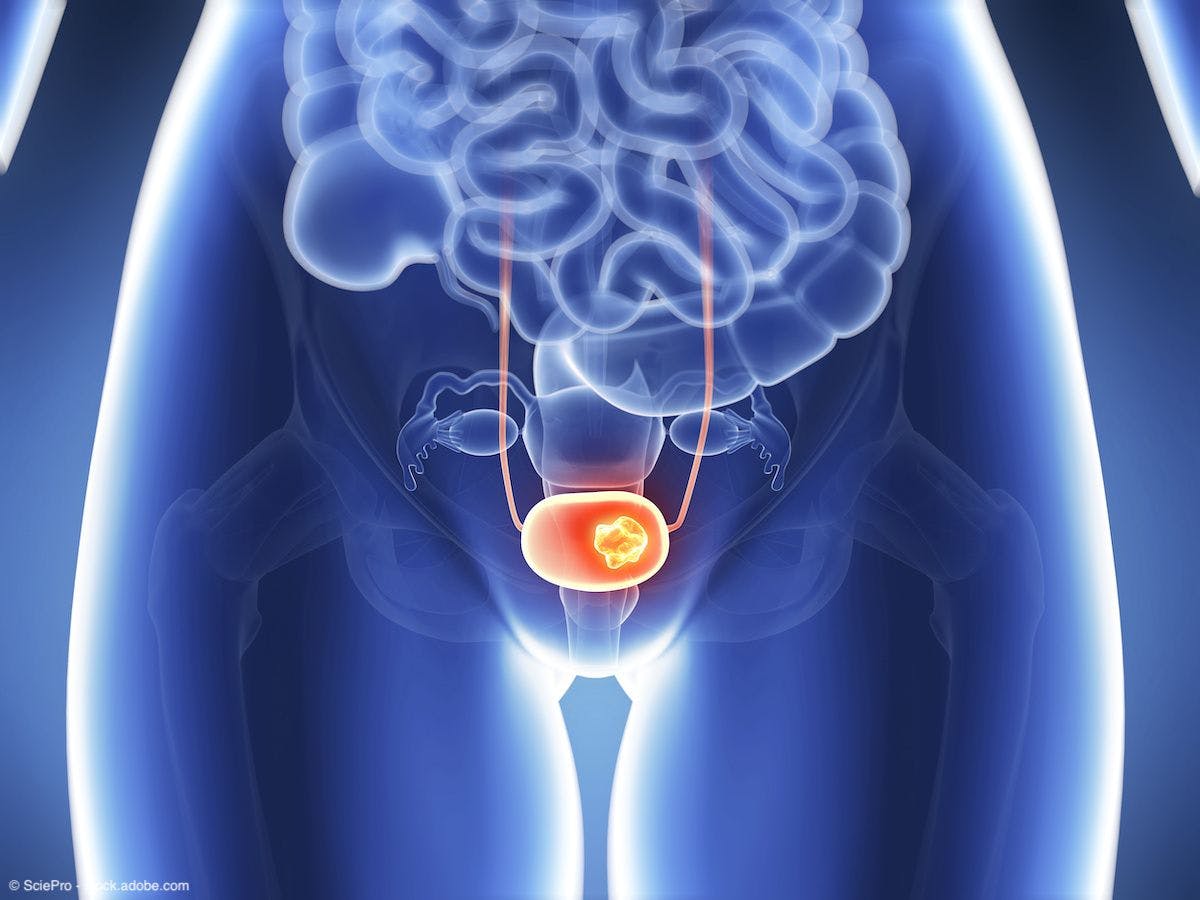Publication
Article
Urology Times Journal
Good to great: The emergence of adjuvant therapy in urologic cancers
Author(s):
"We are...entering a new era for patients with urologic malignancies. Furthermore, we are expanding our reach and influence in patient care designed to improve outcomes," writes Michael S. Cookson, MD, MMHC.
Michael S. Cookson, MD, MMHC, writes, "Ours is an exciting, rapidly changing world, where scientific discoveries and practice-changing trials are being reported more frequently than ever, including in prostate and other urologic cancers."

There was a time when being a good urologist was synonymous with being an outstanding surgeon. But although surgery remains at the core of our practice and we still value surgical skills highly, we must now be more than technicians for our patients with cancer. No longer can we simply perform a technically magnificent radical prostatectomy, nephrectomy, cystectomy, or nephroureterectomy and treat it like a walk-off home run. No longer can we simply report to patients the high risk or adverse pathologic features 2 to 3 weeks after surgery and hope for the best. When better outcomes exist, we have an obligation to inform them of additional treatment options, and this is just as important as the presurgical counseling and postoperative care we provide.
Ours is an exciting, rapidly changing world, where scientific discoveries and practice-changing trials are being reported more frequently than ever, including in prostate and other urologic cancers. Unfortunately, many of these trials are reported at international conferences not regularly attended by urologists. And although the multidisciplinary nature of our care may vary by practice type and setting, we cannot ignore data emerging from well-conducted randomized trials demonstrating improved outcomes with additional postoperative therapy. Now, more than ever, we need to embrace the expertise and added value we can offer patients via a comprehensive multidisciplinary approach.
The management of postprostatectomy patients with adverse pathologic features has been influenced by such studies. In the not-so-distant past, patients with high-risk features, including high-grade disease, seminal vesicle involvement, extracapsular extension, and positive margins, were encouraged to undergo adjuvant radiation therapy based on such trials as SWOG 8794 (NCT00394511).1 However, overtreatment and adverse events from adjuvant radiation therapy in the early postop period tempered enthusiasm for this approach, and many patients were relegated to “way late” treatment. Fortunately, results from 3 randomized trials (RAVES [NCT00860652], RADICALS-RT [NCT00541047], and GETUG-AFU-17 [NCT00667069]) that were confirmed by meta-analysis indicate that early salvage radiation therapy is noninferior to adjuvant radiation for postsurgical treatment of high-risk prostate cancer.2-5 This allows patients time for functional recovery after surgery and facilitates the selection of postsurgical patients who will truly benefit from radiation treatment: those with low but detectable PSA values. The use of prostate-specific membrane antigen PET scans will undoubtedly further refine this approach.
Patients who have undergone renal surgery and are at high risk for recurrence are also potential candidates for additional therapy based on certain pathologic features. Following radical nephrectomy, patients with high-risk renal cell carcinoma may benefit from adjuvant immunotherapy. In the Keynote-564 trial [NCT03142334], patients at high risk for recurrence were randomized after radical nephrectomy to receive placebo or pembrolizumab (Keytruda), a monoclonal antibody against programmed cell death 1 (PD-1).6 The interim results, reported with a follow-up of 24 months, demonstrated adjuvant pembrolizumab was associated with about a 10% improvement in disease-free survival. Although these results are promising, overall survival data have not yet been reported and will be extremely important in garnering further enthusiasm and setting the stage for additional adjuvant recommendations in this context. However, urologists must be aware that adjuvant pembrolizumab is now an option after radical nephrectomy for renal cell carcinoma.
Important new data are also available for the management of urothelial cell carcinoma (UCC). The benefit of chemotherapy before surgery for patients with muscle-invasive bladder cancer has been known for more than 20 years. However, for a variety of reasons, as many as 40% to 50% of patients may not receive chemotherapy prior to cystectomy. Fortunately, new information from a recently completed trial on the use of adjuvant immunotherapy with nivolumab (Opdivo) after radical cystectomy means that the medication can now be considered for patients with high-risk pathologic features irrespective of prior chemotherapy status. With more than 20 months of follow-up, adjuvant nivolumab reduced the risk of disease recurrence after cystectomy by 30%.7 This effect was even more pronounced among those with programmed death ligand 1 (PDL-1) expression greater than or equal to 1%: disease-free survival for them improved by 45%. Based on these results, nivolumab is currently considered an option for adjuvant therapy. Additionally, adjuvant cisplatin-based chemotherapy is also an option for eligible patients with adverse features. For patients with high-risk upper tract UCC, level 1 evidence supports the use of adjuvant cisplatin-based chemotherapy. This data is based on the POUT trial (NCT01993979), a randomized study of high-risk patients after nephroureterectomy that compared observation vs 4 months of adjuvant chemotherapy.8 High-risk patients were those with tumor stages greater than or equal to pT2, evidence of lymph node invasion, or both. At a median follow-up of 2.5 years, receipt of adjuvant chemotherapy significantly improved disease-free survival.
We are thus entering a new era for patients with urologic malignancies. Furthermore, we are expanding our reach and influence in patient care designed to improve outcomes. These precision-based therapies and molecular profiling will enhance our personalized management tools. For those patients with surgical options, the perioperative management and role of adjuvant and early salvage therapies will be increasing. The good urologic surgeon will be experienced and technically savvy, and the great surgeon will not only operate with precision but will also accurately identify and guide those at high-risk for recurrence or metastases.
References
1. Thompson IM, Tangen CM, Paradelo J, et al. Adjuvant radiotherapy for pathological T3N0M0 prostate cancer significantly reduces risk of metastases and improves survival: long-term followup of a randomized clinical trial. J Urol. 2009;181(3):956-962. doi:10.1016/j.juro.2008.11.032
2. Bolla M, van Poppel H, Tombal B, et al. Postoperative radiotherapy after radical prostatectomy for high-risk prostate cancer: long-term results of a randomised controlled trial (EORTC trial 22911). Lancet. 2012;380(9858):2018-2027. doi:10.1016/S0140-6736(12)61253-7
3. Wiegel T, Bartkowiak D, Bottke D, et al. Adjuvant radiotherapy versus wait-and-see after radical prostatectomy: 10-year follow-up of the ARO 96-02/AUO AP 09/95 trial. Eur Urol. 2014;66(2):243-250. doi:10.1016/j.eururo.2014.03.011
4. Parker CC, Clarke NW, Cook AD, et al. Timing of radiotherapy after radical prostatectomy (RADICALS-RT): a randomised, controlled phase 3 trial. Lancet. 2020;396(10260):1413-1421. doi:10.1016/S0140-6736(20)31553-1
5. Vale CL, Fisher D, Kneebone A, et al. Adjuvant or early salvage radiotherapy for the treatment of localised and locally advanced prostate cancer: a prospectively planned systematic review and meta-analysis of aggregate data. Lancet. 2020;396(10260):1422-1431. doi:10.1016/S0140-6736(20)31952-8
6. Choueiri TK, Tomczak P, Park SH, et al. Adjuvant pembrolizumab after nephrectomy in renal-cell carcinoma. N Engl J Med. 2021;385(8):683-694. doi:10.1056/NEJMoa2106391
7. Bajorin DF, Witjes JA, Gschwend JE, et al. Adjuvant nivolumab versus placebo in muscle-invasive urothelial carcinoma. N Engl J Med. 2021;384(22):2102-2114. doi:10.1056/NEJMoa2034442
8. Birtle A, Johnson M, Chester J, et al: Adjuvant chemotherapy in upper tract urothelial carcinoma (the POUT trial): a phase 3, open-label, randomised controlled trial. Lancet. 2020;395(10232):1268-1277. doi:10.1016/S0140-6736(20)30415-3

























